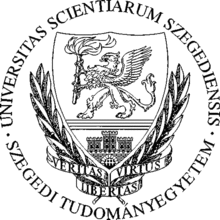
Back جامعة زيجيد Arabic Сегедскі ўніверсітэт Byelorussian Сэгедзкі ўнівэрсытэт BE-X-OLD Сегедски университет Bulgarian Universität der Wissenschaften Szeged German Scienca Universitato de Szeged Esperanto Universidad de Szeged Spanish Szegedi Teadusülikool Estonian دانشگاه سگد Persian Université de Szeged French
Szegedi Tudományegyetem | |
 | |
| Latin: Universitas Szegediensis[1] | |
Former name | Ferenc József University of Kolozsvár, József Attila Tudományegyetem |
|---|---|
| Motto | Latin: Veritas. Virtus. Libertas |
Motto in English | Truth. Bravery. Freedom. |
| Type | Public research university |
| Established | 1872 |
| Founder | Franz Joseph I |
| Affiliation | European University Association, Science Without Borders, Confucius Institute |
| Budget | US$220 million |
| Chancellor | Judit Fendler |
| Rector | László Rovó |
Academic staff | 1,968 |
Administrative staff | 2,200 |
| Students | 22,693[2] |
| Undergraduates | 17,384[2] |
| Postgraduates | 2,668[2] |
| 714[2] | |
Other students | 3,997[3] (international) |
| Location | , Hungary 46°15′01″N 20°08′46″E / 46.25028°N 20.14611°E |
| Campus | Urban |
| Language | Hungarian, English |
| Colours | Blue |
| Website | www |
The University of Szeged (Hungarian: Szegedi Tudományegyetem) is a public research university in Szeged, Hungary. Established as the Jesuit Academy of Kolozsvár in present-day Cluj-Napoca in 1581, the institution was re-established as a university in 1872 by Emperor Franz Joseph I. The university relocated to Szeged in 1921, making it one of the oldest research universities in Hungary. It went through numerous changes throughout the 20th century and was eventually divided into distinct independent universities.
The current University of Szeged was formed in 2000 and is made up of twelve constituent faculties and nineteen doctoral schools, which consist of a range of departments and research groups. Each faculty functions autonomously. In addition to these, the university also operates the Health Centre of the University of Szeged, an extensive teaching hospital responsible for public regional healthcare, and three laboratory schools, which combine public education and teacher training responsibilities. The faculties and associated buildings do not form one single campus, as the buildings are scattered around downtown Szeged, although the Health Centre and the buildings of the Department of Arts are adjacent to each other. Being part of the Bologna zone, most majors are divided into a Bachelor's and Master's and PhD programmes, but the so-called one tyre-master (undivided) programmes are also.[4]
The university also operates the Klebelsberg Library, the largest university library in Central Europe, and six university presses. In the fiscal year of 2014, the university had an operating budget of US$220 million.[5] The University of Szeged has educated a large number of notable alumni, including Nobel laureates Albert Szent-Györgyi and Katalin Karikó, political scientist István Bibó, and poets Attila József and Gyula Juhász.
- ^ "Search". Internet Archive.
- ^ a b c d Szegedi Tudományegyetem 2015. évi beszámoló szöveges értékelése. 2015.
- ^ "University of Szeged". Top Universities. Retrieved 18 May 2021.
- ^ "University of Szeged | Study Programmes at the University of Szeged". u-szeged.hu. 13 April 2021. Retrieved 9 October 2021.
- ^ "Budgetary Data". SZTE. 24 February 2012. Retrieved 30 March 2014.